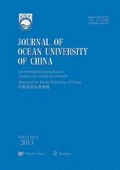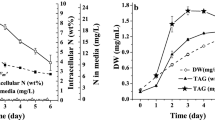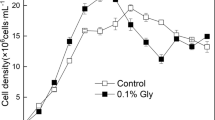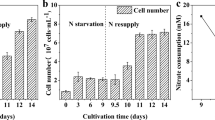Abstract
Stress state of microalgal cells is caused under unfavorable conditions such as disordered light regime and depleted nitrogen. The stress state can impair photosynthetic efficiency, inhibit cell growth and result in the accumulation of triacylglycerol (TAG) from protective mechanisms. Continuous light or nitrogen starvation was applied on microalgae and performed effectively on inducing TAG production. To evaluate the light regime effect on inducing TAG production, the effect of different light regimes on nitrogen-starved Isochrysis zhangjiangensis was investigated in this work. The continuous light and nitrogen starvation elevated TAG content of biomass by 73% and 193%, respectively. Furthermore, the TAG accumulation of I. zhangjiangensis cell under nitrogen starvation decreased under aggravated stress from continuous illumination. Our results demonstrated that culturing the cells with 14L: 10D light regime under nitrogen starvation is the optimal mode to achieve maximal accumulation of TAG. A recovery in light regime was necessary for I. zhangjiangensis cultivation.
Similar content being viewed by others
References
Chi, L., Yao, C. H., Cao, X. P., and Xue, S., 2016. Coordinated regulation of nitrogen supply mode and initial cell density for energy storage compounds production with economized nitrogen utilization in a marine microalga Isochrysis zhangjiangensis. Bioresource Technology, 200: 598–605.
Cross, F. R., and Umen, J. G., 2015. The Chlamydomonas cell cycle. The Plant Journal. 82: 370–392.
Diamond, S., Jun, D., Rubin, B. E., and Golden, S. S., 2015. The circadian oscillator in Synechococcus elongatus controls metabolite partitioning during diurnal growth. Proceedings of the National Academy of Sciences of the United States of America, 112: E1916–1925.
Edmundson, S. J., and Huesemann, M. H., 2015. The dark side of algae cultivation: Characterizing night biomass loss in three photosynthetic algae, Chlorella sorokiniana, Nannochloropsis salina and Picochlorum sp. Algal Research, 12: 470–476.
Feng, D. N., Chen, Z. A., Xue, S., and Zhang, W., 2011. Increased lipid production of the marine oleaginous microalgae Isochrysis zhangjiangensis (Chrysophyta) by nitrogen supplement. Bioresource Technology, 102: 6710–6716.
Goncalves, E. C., Wilkie, A. C., Kirst, M., and Rathinasabapathi, B., 2016. Metabolic regulation of triacylglycerol accumulation in the green algae: Identification of potential targets for engineering to improve oil yield. Plant Biotechnology Journal, 14 (8): 1649–1660.
Goold, H. D., Cuine, S., Legeret, B., Liang, Y. X., Brugiere, S., Auroy, P., Javot, H., Tardif, M., Jones, B., Beisson, F., Peltier, G., and Li–Beisson, Y. H., 2016. Saturating light induces sustained accumulation of oil in plastidal lipid droplets in Chlamydomonas reinhardtii. Plant Physiology, 171: 4.
Hennessey, T. L., and Field, C. B., 1991. Circadian rhythms in photosynthesis: Oscillations in carbon assimilation and stomatal conductance under constant conditions. Plant Physiology, 96: 831–836.
Hu, Q., Sommerfeld, M., Jarvis, E., Ghirardi, M., Posewitz, M., Seibert, M., and Darzins, A., 2008. Microalgal triacylglycerols as feedstocks for biofuel production: Perspectives and advances. The Plant Journal, 54: 621–639.
Jacob–Lopes, E., Scoparo, C. H. G., Lacerda, L. M. C. F., and Franco, T. T., 2009. Effect of light cycles (night/day) on CO2 fixation and biomass production by microalgae in photobioreactors. Chemical Engineering and Processing, 48: 306–310.
Klok, A. J., Lamers, P. P., Martens, D. E., Draaisma, R. B., and Wijffels, R. H., 2014. Edible oils from microalgae: insights in TAG accumulation. Trends in Biotechnology, 32: 10.
Liu, J., Liu, Y., Wang, H., and Xue, S., 2015. Direct transesterification of fresh microalgal cells. Bioresource Technology, 176: 284–287.
Meng, Y. Y., Jiang, J. P., Wang, H. T., Cao, X. P., Xue, S., Yang, Q., and Wang, W. L., 2015. The characteristics of TAG and EPA accumulation in Nannochloropsis oceanica IMET1 under different nitrogen supply regimes. Bioresource Technology, 179: 483–489.
Murchie, E. H., and Lawson, T., 2013. Chlorophyll fluorescence analysis: A guide to good practice and understanding some new applications. Journal of Experimental Botany, 64 (13): 3983–3998.
Nath, K., Jajoo, A., Poudyal, R. S., Timilsina, R., Park, Y. S., Aro, E. M., Nam, H. G., and Lee, C. H., 2013. Towards a critical understanding of the photosystem II repair mechanism and its regulation during stress conditions. FEBS Letters, 587: 3372–3381.
Nitschke, S., Cortleven, A., Iven, T., Feussner, I., Havaux, M., Riefler, M., and Schmülling, T., 2016. Circadian stress re gimes affect the circadian clock and cause jasmonic acid–dependent cell death in cytokinin–deficient Arabidopsis plants. The Plant Cell, 28: 1616–1639.
Polle, J. E. W., and Melis, A., 1999. Recovery of the photosynthetic apparatus from photoinhibition during dark incubation of the green alga Dunaliella salina. Australian Journal of Plant Physiology, 26: 679–686.
Quinn, G. P., and Keough, M. J., 2002. Experimental Design and Data Analysis for Biologists: Analyses of Covariance. Cambridge University Press, Cambridge, DOI: 10.1017/CBO9780511806384.
Ruangsomboon, S., 2012. Effect of light, nutrient, cultivation time and salinity on lipid production of newly isolated strain of the green microalga, Botryococcus braunii KMITL 2. Bioresource Technology, 109: 261–265.
Sforza, E., Simionato, D., Giacometti, G. M., Bertucco, A., and Morosinotto, T., 2012. Adjusted light and dark cycles can optimize photosynthetic efficiency in algae growing in photobioreactors. PLoS One, 7, 6: e38975.
Singh, S. P., and Singh, P., 2015. Effect of temperature and light on the growth of algae species: A review. Renewable and Sustainable Energy Reviews, 50: 431–444.
Tamburic, B., Zemichael, F. W., Maitland, G. C., and Hellgardt, K., 2012. Effect of the light regime and phototrophic conditions on growth of the H2–producing greenalga Chlamydomonas reinhardtii. Energy Procedia, 29: 710–719.
Thevenieau, F., and Nicaud, J. M., 2013. Microorganisms as sources of oils. Oilseeds and Fats, Crops and Lipids, 20: D603.
Toro, J. E., 1989. The growth rate of two species of microalgae used in shellfish hatcheries cultured under two light regimes. Aquaculture Research, 20: 249–254.
Wang, H. T., Meng, Y. Y., Cao, X. P., Ai, J. N., Zhou, J. N., Xue, S., and Wang, W. L., 2015. Coordinated response of photosynthesis, carbon assimilation, and triacylglycerol accumulation to nitrogen starvation in the marine microalgae Isochrysis zhangjiangensis (Haptophyta). Bioresource Technology, 177: 282–288.
Wang, H. T., Yao, C. H., Ai, J. N., Cao, X. P., Xue, S., and Wang, W. L., 2014. Identification of carbohydrates as the major carbon sink of the marine microalga Isochrysis zhangjiangensis (Haptophyta) and optimization of its productivity by nitrogen manipulation. Bioresource Technology, 171: 298–304.
Wang, H. T., Yao, C. H., Liu, Y. N., Meng, Y. Y., Wang, W. L., Cao, X. P., and Xue, S., 2015. Identification of fatty acid biomarkers for quantification of neutral lipids in marine microalgae Isochrysis zhangjiangensis. Journal of Applied Phycology, 27 (1): 249–255.
Yoshimura, T., Okada, S., and Honda, M., 2013. Culture of the hydrocarbon producing microalga Botryococcus braunii strain Showa: optimal CO2, salinity, temperature, and irradiance conditions. Bioresource Technology, 133: 232–239.
Acknowledgements
This study was supported by the National High Technology Research and Development Program ‘863’ (No. 2012 AA052101) and the Hundred Talent Program of the Chinese Academy of Sciences (No. A1097).
Author information
Authors and Affiliations
Corresponding author
Rights and permissions
About this article
Cite this article
Fan, X., Cao, X., Chu, Y. et al. The Light Regime Effect on Triacylglycerol Accumulation of Isochrysis zhangjiangensis. J. Ocean Univ. China 18, 474–480 (2019). https://doi.org/10.1007/s11802-019-3691-2
Received:
Revised:
Accepted:
Published:
Issue Date:
DOI: https://doi.org/10.1007/s11802-019-3691-2




